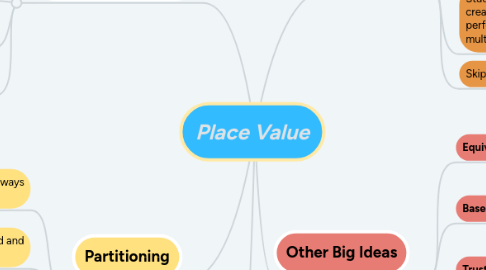
1. Other Learning Area
1.1. Literacy
1.1.1. Students exercise their ability to read and write to demonstrate place value.
2. Positional Property
2.1. The order of the numbers makes a difference. (Hurst & Hurrell, 2014)
2.2. The quantities represented by the individual digits are determined by the position they hold within the whole numeral (Hurst & Hurrell, 2014).
2.3. Place value columns have names
2.3.1. Ones, tens, hundreds and so on.
2.4. Zero can hold a place (Hurst & Hurrell, 2014).
2.5. Decimals
2.5.1. Decimal place value is an extension of whole number place value (Charles, 2005)
3. Partitioning
3.1. Numbers can be partitioned in flexible ways (Hurst & Hurrell, 2014).
3.1.1. Standard: 671=600+70+1
3.1.2. Non - standard: 671= 471+ 200
3.2. Recognise numbers in standard and expanded form (ACARA, n.d.)
3.3. Additive property: The quantity represented by the whole numeral is the sum of the values represented by the individual digits (Hurst & Hurrell, 2014).
4. Other Big Ideas
4.1. Equivalence
4.1.1. Numbers can be named in equivalent ways using place value For example 3 hundreds 5 tens is equivalent to 35 tens (Charles, 2005)
4.2. Base Ten Property
4.2.1. Each place value to the left of another is ten times greater than the one to the right for example: 100 = 10 x 10 (Charles, 2005).
4.3. Trust the Count
4.3.1. Is the first big idea students develop and is the foundation on which place value is built (Hurst & Hurrell, 2014).
4.4. Multiplicative thinking
4.4.1. Conceptual understanding of place value is essential to developing multiplicative thinking. One main concept is understanding that zero can hold a place (Hurst & Hurrell, 2014).
